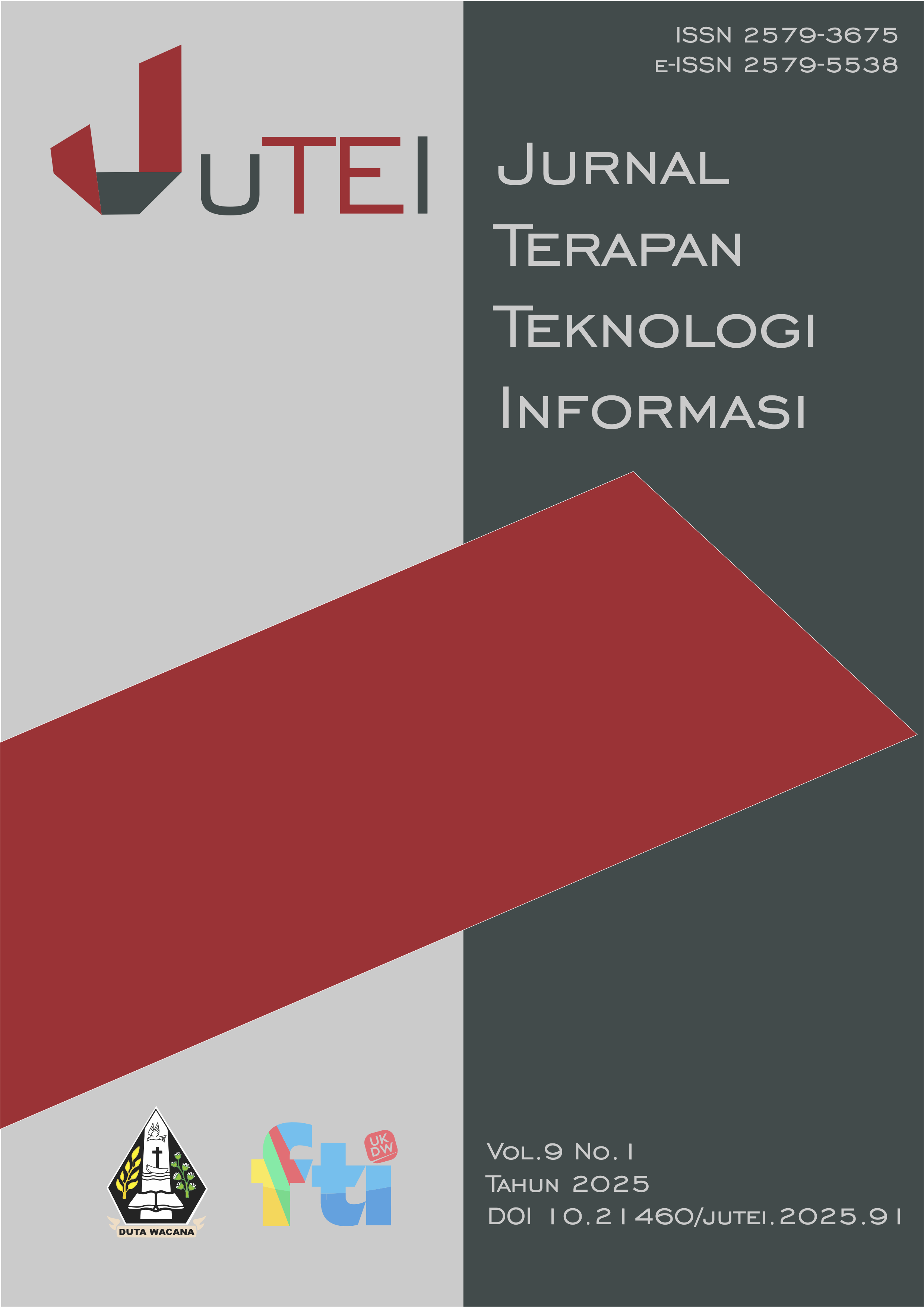Desain Model Relational Database Perpustakaan SMP Negeri 13 Tarakan menggunakan Metode Database Life Cycle
DOI:
https://doi.org/10.21460/jutei.2025.91.398Keywords:
DBLC, Library, Database, Information SystemsAbstract
The library is a essential educational service unit supporting schools' learning and teaching process. As a source of information and knowledge, the library provides various resources, such as books, journals, and other learning media, which can be utilized by students, teachers, and school staff to enrich their insights and improve the quality of education. This study uses the Database Life Cycle method to design an effective and integrated relational database model for the school library system. This method includes the stages of needs analysis, conceptual design, logical design, physical design, and implementation and testing. Through the design and implementation process, a library database model is produced consisting of 8 main tables, the table is anggota, jenis anggota, siswa, guru, staf_tu, buku, letak_buku, and peminjaman. These tables are related to each other to maintain data integrity and facilitate the process of processing information related to the library. The final results show that the designed library database can support all library activities and services effectively, from member data management, book catalogs, and borrowing to reporting. This database has been proven to receive data well through testing and is ready to be implemented in a more comprehensive library information system.
References
A. Nurseptaji, A. Adamsyah, M. Wildan, M. Akmal, P. Ardiansyah, and R. Firmansyah, “Analisa Proyek Pengembangan Sistem Informasi Perpustakaan Umum menggunakan Unified Modeling Language,” JUSS (Jurnal Sains dan Sist. Informasi), vol. 3, no. 2, pp. 35–42, Dec. 2020, doi: 10.22437/juss.v3i2.10839.
S. Setiawansyah, Q. J. Adrian, and R. N. Devija, “Penerapan Sistem Informasi Administrasi Perpustakaan menggunakan Model Desain User Experience,” J. Manaj. Inform., vol. 11, no. 1, pp. 24–36, Apr. 2021, doi: 10.34010/jamika.v11i1.3710.
C. Seasholes, L. Kimery, and C. Kaaland, “School Library Research: Guest Editors’ Introduction,” Peabody J. Educ., vol. 98, no. 1, pp. 83–84, Jan. 2023, doi: 10.1080/0161956X.2023.2160111.
Y. Rahmanto, D. Alita, A. D. Putra, P. Permata, and S. Suaidah, “Penerapan Sistem Informasi Perpustakaan Berbasis Web pada SMK Nurul Huda Pringsewu,” J. Soc. Sci. Technol. Community Serv., vol. 3, no. 2, p. 151, 2022, doi: 10.33365/jsstcs.v3i2.2009.
K. Li, Y. Ding, X. He, L. Shi, and X. Ma, “Research and Practice on Business Architecture Construction of Large Integrated System,” in 2020 International Conference on Computer Engineering and Application (ICCEA), IEEE, Mar. 2020, pp. 178–182. doi: 10.1109/ICCEA50009.2020.00046.
R. B. Bambang Sumantri and F. Mahardika, “Perancangan Basis Data Sistem Informasi Penjualan Barang (Studi Kasus: Minimarket ‘ABC’ Sidareja),” J. Teknol. dan Bisnis, vol. 2, no. 1, pp. 61–68, Jul. 2020, doi: 10.37087/jtb.v2i1.16.
S. Purba, “Database Development Methodology and Organization,” Inf. Syst. Manag., vol. 16, no. 1, pp. 72–77, Jan. 1999, doi: 10.1201/1078/43187.16.1.19990101/31164.10.
M. R. Anwar and S. Purnama, “Boarding House Search Information System Database Design,” Int. J. Cyber IT Serv. Manag., vol. 2, no. 1, pp. 70–81, Mar. 2022, doi: 10.34306/ijcitsm.v2i1.89.
M. P. Putri and H. Effendi, “Database Design for Website Service Guide ‘Waterfall Tour South Sumatera,’” J. Phys. Conf. Ser., vol. 1167, p. 012069, Feb. 2019, doi: 10.1088/1742-6596/1167/1/012069.
Y. Andrian, L. O. M. Musafar, S. K. Fatimah, and R. Priyatikanto, “The Implementation of DBLC Design Model for Orbital Database System,” in 2021 International Seminar on Intelligent Technology and Its Applications (ISITIA), IEEE, Jul. 2021, pp. 303–308. doi: 10.1109/ISITIA52817.2021.9502237.
Tri Amri Wijaya, Constantin Menteng, Afis Julianto, Adi Surya, and Ema Utami, “Perancangan Desain Basis Data Sistem Informasi Geografis Tanah Penduduk dengan Menerapkan Model Data Relasional (Studi Kasus : Desa Tumbang Mantuhe Kabupaten Gunung Mas Provinsi Kalimantan Tengah),” J. Teknol. Inf. J. Keilmuan dan Apl. Bid. Tek. Inform., vol. 15, no. 1, pp. 72–81, Jan. 2021, doi: 10.47111/jti.v15i1.1867.
S. S. Wibagso and E. Lia, “Desain Model Database Layanan Panti Werdha dengan Menerapkan Metode Database Life Cycle,” J. Tek. Inform. dan Sist. Inf., vol. 6, no. 3, Dec. 2020, doi: 10.28932/jutisi.v6i3.3047.
N. Nurhayati, E. Nur Rahmawati, I. Dwi Anand Sinar Putra, and D. Rizky Maulana, “Designing a Child Behavior Disorder Expert System Database Using the Database Life Cycle Method,” Proceeding Int. Conf. Sci. Heal. Technol., pp. 430–442, Sep. 2024, doi: 10.47701/icohetech.v5i1.4223.
A. E. Putri, “EVALUASI PROGRAM BIMBINGAN DAN KONSELING: SEBUAH STUDI PUSTAKA,” JBKI (Jurnal Bimbing. Konseling Indones., vol. 4, no. 2, p. 39, Oct. 2019, doi: 10.26737/jbki.v4i2.890.
F. W. Roosinda et al., Metode Penelitian Kuantitatif, 1st ed. Yogyakarta: Zahir Publishing, 2021.
S. Samidi and R. Hidayat, “Desain Model Database Mutasi Siswa Dengan Menerapkan Metode Database Life Cycle,” Technomedia J., vol. 8, no. 2SP, pp. 221–235, Jul. 2023, doi: 10.33050/tmj.v8i2SP.2063.
M. A. Fajar, S. Afifah, B. K. S. Nugraha, I. N. Sari, A. Sakinah, and M. R. F. Ariq, “Perancangan Basis Data Open Trip Pendakian Gunung pada sukatraveler.id dengan Metode DBLC,” J. Ilm. Sist. Inf., vol. 4, no. 1, pp. 1–14, Jul. 2024, doi: 10.46306/sm.v4i1.67.
I. Listiawan and Y. Marsongko, “Model Database Revitalisasi Lumbung Pangan Desa (Studi Kasus Desa Penen Kecamatan Ngaglik Sleman Yogyakarta),” in Prosiding Seminar Nasional Multidisiplin Ilmu, Sleman, 2020, pp. 343–350.
Downloads
Published
How to Cite
Issue
Section
License
Copyright (c) 2025 Syaddam, Muhammad Yusril, Agustinus Jimi Jon Kawuta, Sehlmi Duwiputri Banni, Yakobus Silfianus Ratu

This work is licensed under a Creative Commons Attribution-NonCommercial-NoDerivatives 4.0 International License.
Authors who publish articles in JUTEI agree on the following rules:
1. The author grants non exclusive royalty free rights, and is willing to publish articles online and complete (full access). With such rights JUTEI reserves the right to save, transfers, manages in various forms, maintains and publishes articles while keeping the author's name as the copyright owner.
2. Each author contained in the article has contributed fully to the substance and intellectual, and is accountable to the public. If in the future there is a copyright infringement notification then this will be responsibility of the author, not JUTEI.







